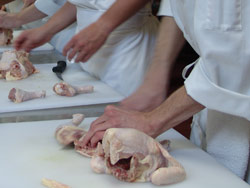
He also notes the importance of preparing students for the pressure cooker culture inherent to kitchens: “What Kendall is known for is its intense learning environment.
CULINARY FUNDAMENTALS DAY 22 HOW TO
“Cooking fundamentals have to be taught: People have to know how to use a knife, how to bake properly and fold dough, how to sauté.”Ĭhristopher Koetke, vice president of culinary arts at Kendall College, echoes that the foundational piece of a culinary education doesn’t change. The rigorous teaching of the classic fundamentals of cooking can’t be short-circuited or sidestepped,” says Peter Lehmuller, dean of the College of Culinary Arts at Johnson & Wales University. “What remains important is a sense of continuity.

CULINARY FUNDAMENTALS DAY 22 PROFESSIONAL
Whether a program is like IOT, which offers a Professional Associate in Occupational Studies (AOS) degree, or is a university offering a bachelor’s degree, top school administrators agree that a quality education begins with basic cooking fundamentals and a realistic perception of what an intense kitchen culture entails. Recently the program transitioned to three sessions-morning, afternoon, or night schedules-so the school could bring class sizes down to 15 students per class instead of 25 to 30 people. The school, which has more than 240 students enrolled at its two campuses, has seven teaching kitchens and includes nine courses of full-time kitchen work. Kevin Arnett, culinary program director at the Institute of Technology Culinary School in Clovis, California, explains, “We have to place 80 percent of our students within 60 days of graduation,” or the program would be at risk to lose funding from the federal government.

That educational expertise exists in trade schools as well as university settings.

The quality of the education depends upon many factors-the qualifications of chef instructors, the student-teacher ratio, and the amount of time spent in hands-on kitchen practice-all of which speak to the value and viability of the culinary curriculum. Real success is measured not in dollars invested but rather in how prepared graduates are and the school’s job placement rate. Costs range from six-figure tuitions akin to Ivy League degrees to more affordable programs that may be completed in months not years and often are funded by federal grants or scholarships. Accreditation by organizations such as the American Culinary Federation Education Foundation (ACFEF) or the Accrediting Commission of Career Schools and Colleges (ACCSC) adds a weighty stamp of authority. The top schools have proven reputations with strong ties to leaders in the industry and alumni who are excelling in foodservice. There are, however, certain characteristics that hold true across all of the best culinary curricula. Among this group, the culinary curricula and degrees are as varied as the opportunities for careers post-graduation-and that diversity reflects the needs of those hiring graduates as well as those applying to schools.įrom baccalaureate degrees awarded by The Culinary Institute of America (CIA) and Johnson & Wales University, to diploma programs at the Institute of Culinary Education and the International Culinary Center, to associate degrees and certification programs at schools around the country, don't expect the best culinary educations to look alike. Starting with lists that named more than 1,000 schools and educational programs, FSR researched and identified 22 top schools. For operators and chefs, it helps to know the best programs to recruit from and how culinary education and foodservice careers are evolving. To answer this demand, top culinary schools around the country are working to keep the employment pipeline filled with well-trained graduates. The National Restaurant Association predicts 1.7 million new restaurant jobs will be created in the decade leading up to 2026.

The shortage of skilled kitchen labor: That's what everyone keeps talking about, and it isn't going to change any time soon.


 0 kommentar(er)
0 kommentar(er)
